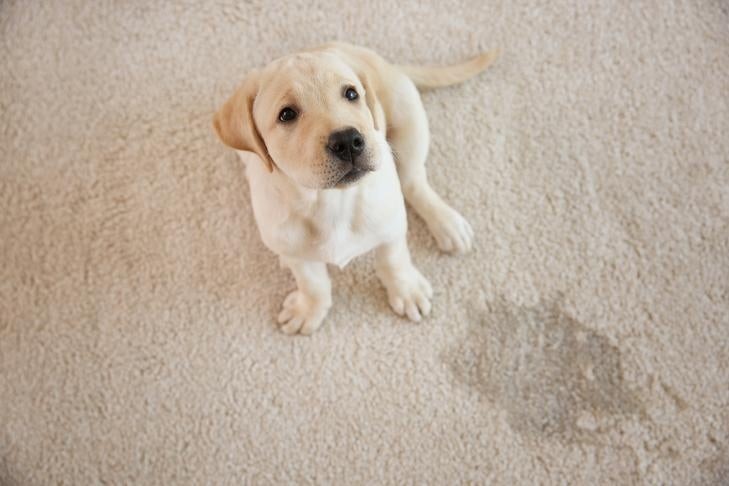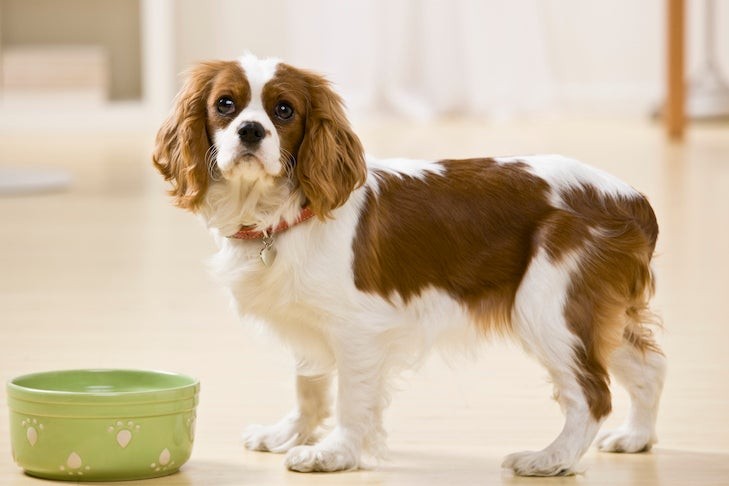Potty training a puppy is a crucial first step toward ensuring a harmonious life together, and HOW.EDU.VN offers expert guidance to navigate this important stage. Mastering housebreaking techniques not only prevents unwanted messes but also strengthens the bond between you and your furry friend. Discover proven strategies for successful house training, including crate training, schedule management, and positive reinforcement, ensuring a well-behaved and happy companion by consulting with our Doctors. Explore related topics such as canine behavior, dog training tips, and puppy care advice.
1. Understanding Puppy Potty Training
Potty training, also known as housebreaking or house training, is the process of teaching your puppy where and when it is appropriate to eliminate waste. Success hinges on consistency, patience, and understanding your puppy’s needs. This critical phase sets the foundation for a clean and comfortable living environment for both you and your dog.
1.1. Why Potty Training Is Essential
Effective potty training is paramount for several reasons:
- Hygiene: Prevents unsanitary conditions in your home.
- Property Protection: Safeguards your furniture, flooring, and belongings from damage.
- Social Acceptance: Ensures your dog is welcome in various environments.
- Dog Welfare: A well-trained dog experiences less stress and anxiety.
- Bonding: The training process strengthens the bond between you and your puppy.
According to a study published in the Journal of Veterinary Behavior, dogs who are not properly house-trained are more likely to be surrendered to shelters. Consistent training significantly reduces this risk, fostering a lifelong bond between pet and owner.
1.2. Setting Realistic Expectations
Puppies have limited bladder control, so accidents are inevitable. Expect setbacks and avoid punishment. Understand that puppies can generally hold their bladder for the number of hours corresponding to their age in months, up to about nine months.
| Puppy Age (Months) | Bladder Control (Hours) |
|---|---|
| 2 | 2 |
| 3 | 3 |
| 4 | 4 |
| 5 | 5 |
| 6 | 6 |




Remember, these are estimates, and individual puppies may vary. Regular vet check-ups are crucial to rule out underlying health issues affecting continence, as highlighted by the American Animal Hospital Association (AAHA).
Alt: Puppy training outdoors, reinforcing positive behavior.
2. Preparing for Potty Training
Before starting, gather essential supplies and establish a routine. A well-prepared environment can significantly ease the training process.
2.1. Essential Supplies
- Crate: Choose one that’s appropriately sized for your puppy.
- Leash: For supervised outdoor trips.
- Collar: With identification tags.
- Pet Stain and Odor Remover: Enzymatic cleaner to eliminate odors completely.
- Treats: Small, tasty rewards for positive reinforcement.
- Puppy Pads: Optional for indoor training or emergencies.
2.2. Choosing a Potty Spot
Select a designated outdoor area for your puppy to relieve themselves. Consistency is crucial. Always take your puppy to the same spot to help them associate the area with elimination. According to the American Society for the Prevention of Cruelty to Animals (ASPCA), scent marking encourages repeat visits to the same location.
2.3. Establishing a Routine
A predictable schedule is key. Take your puppy out:
- First thing in the morning.
- After every meal.
- After naps.
- After playtime.
- Before bedtime.
Consistency helps regulate your puppy’s digestive system and reduces the likelihood of accidents. Maintaining a structured feeding schedule also aids in predicting bowel movements, as noted in The Merck Veterinary Manual.
3. Crate Training for Potty Training
Crate training is a highly effective method for housebreaking. Dogs instinctively avoid soiling their sleeping areas, making the crate a valuable tool.
3.1. Introducing the Crate
Make the crate a positive space:
- Place treats and toys inside.
- Feed your puppy meals in the crate.
- Start with short periods and gradually increase the duration.
- Never use the crate as punishment.
Dr. Sophia Yin, a renowned veterinary behaviorist, emphasizes that the crate should be a safe haven for your puppy. Forcing a puppy into a crate can create negative associations and hinder the training process.
3.2. Using the Crate for Potty Training
- Take your puppy out immediately after they come out of the crate.
- Praise and reward them when they eliminate outside.
- If they don’t eliminate, return them to the crate for a short period, then try again.
Ensure the crate is appropriately sized. It should be just large enough for your puppy to stand, turn around, and lie down comfortably. Too much space can defeat the purpose, allowing them to eliminate in one area and sleep in another, as explained in Decoding Your Dog, a book by the American College of Veterinary Behaviorists.
3.3. Troubleshooting Crate Training Issues
If your puppy is soiling their crate, consider the following:
- Vet Check-Up: Rule out medical issues.
- Crate Size: Ensure it’s the right size.
- Cleaning: Thoroughly clean the crate to remove odors.
- Potty Breaks: Increase frequency.
- Training Regression: Revisit the initial steps of crate training.
4. Potty Training Without a Crate
While crate training is effective, it’s not always feasible for every owner or puppy. Alternative methods can be equally successful with patience and consistency.
4.1. Supervise and Restrict
Constant supervision is crucial. Keep your puppy in a confined area, such as a puppy-proofed room, when you can’t actively watch them.
4.2. Leash Training Indoors
Attach a leash to your puppy and keep them with you inside. This allows you to monitor their behavior closely and quickly intervene if they show signs of needing to go.
4.3. Recognizing the Signs
Learn to recognize your puppy’s signals:
- Whining
- Scratching at the door
- Squatting
- Circling
- Restlessness
According to a study in Applied Animal Behaviour Science, early recognition of these cues significantly reduces indoor accidents.
4.4. Consistent Schedule
Maintain a strict schedule for potty breaks, even without a crate. Take your puppy out at regular intervals and after key activities.
Alt: Puppy on leash, enjoying outdoor walk and potty break.
5. Positive Reinforcement Techniques
Positive reinforcement is a cornerstone of effective potty training. Reward desired behavior to encourage repetition.
5.1. Immediate Praise
When your puppy eliminates outside, offer immediate verbal praise. Use an enthusiastic tone and positive words like “Good potty” or “Yes.”
5.2. Tasty Treats
Pair verbal praise with a small, tasty treat. This creates a strong association between the action and the reward.
5.3. Consistency is Key
Always praise and reward your puppy immediately after they eliminate outside. Inconsistency can confuse your puppy and slow down the training process.
5.4. Avoid Punishment
Never punish your puppy for accidents. Punishment can create fear and anxiety, making them less likely to eliminate in front of you, even when outside. The Humane Society of the United States strongly advises against punitive training methods.
6. Addressing Common Potty Training Challenges
Even with the best efforts, challenges can arise. Addressing these issues promptly can prevent long-term problems.
6.1. Accidents Indoors
- Clean Thoroughly: Use an enzymatic cleaner to eliminate odors.
- Revisit the Schedule: Ensure frequent potty breaks.
- Supervise Closely: Prevent unsupervised access to accident-prone areas.
- Consider Medical Issues: Consult with your veterinarian.
6.2. Resistance to Going Outside
- Make it Appealing: Use toys or treats to entice your puppy outside.
- Go with Them: Your presence can provide reassurance.
- Be Patient: Some puppies take time to adjust to outdoor elimination.
- Weather Considerations: Protect your puppy from extreme weather conditions.
6.3. Inconsistent Elimination
- Track Patterns: Monitor your puppy’s elimination habits to identify triggers.
- Dietary Adjustments: Ensure a high-quality, consistent diet.
- Veterinary Consultation: Rule out underlying health issues.
Alt: Puppy accident indoors, emphasizing importance of cleaning thoroughly.
7. Potty Pads and Indoor Solutions
For some owners, potty pads or indoor dog bathrooms offer practical solutions, especially for small breeds or those living in apartments.
7.1. Using Potty Pads
- Placement: Place the pad in a designated area away from eating and sleeping spaces.
- Introduction: Introduce your puppy to the pad, especially after waking up and eating.
- Positive Reinforcement: Praise and reward your puppy for using the pad.
- Gradual Transition: Gradually move the pad closer to the door if you eventually want your puppy to eliminate outside.
7.2. Indoor Dog Bathrooms
Indoor dog bathrooms, such as artificial grass patches or litter boxes, provide a more permanent indoor solution.
- Training: Train your puppy to use the indoor bathroom using similar techniques as potty pad training.
- Maintenance: Regularly clean the bathroom to prevent odors and maintain hygiene.
7.3. Combining Indoor and Outdoor Training
Some owners use a combination of indoor and outdoor training, especially during early puppyhood or inclement weather.
- Consistency: Maintain a consistent schedule and use positive reinforcement for both indoor and outdoor elimination.
- Communication: Clearly communicate your expectations to your puppy.
8. Medical Considerations
Medical issues can sometimes contribute to potty training difficulties. Consulting with your veterinarian is essential to rule out underlying health problems.
8.1. Urinary Tract Infections (UTIs)
UTIs can cause frequent urination and accidents. Symptoms include:
- Frequent urination
- Straining to urinate
- Blood in urine
- Licking the genital area
8.2. Bladder Stones
Bladder stones can also lead to urinary issues. Symptoms include:
- Frequent urination
- Painful urination
- Blood in urine
8.3. Incontinence
Incontinence, or loss of bladder control, can be caused by various factors, including:
- Age-related changes
- Hormonal imbalances
- Neurological issues
8.4. Diabetes and Kidney Disease
These conditions can increase thirst and urination, leading to accidents.
Regular veterinary check-ups can help diagnose and manage these conditions, ensuring your puppy’s overall health and facilitating successful potty training.
9. Advanced Potty Training Tips
Once your puppy has mastered the basics, consider these advanced tips to reinforce good habits and address specific situations.
9.1. Generalization
Train your puppy to eliminate in different locations, such as parks or friends’ houses. This helps them generalize their training and become more adaptable.
9.2. On-Leash Potty Training
Teach your puppy to eliminate on leash in various environments. This is especially useful for urban settings or when traveling.
9.3. Command Training
Associate a specific command, such as “Go potty,” with elimination. This can help prompt your puppy to eliminate on cue.
9.4. Nighttime Potty Training
- Limit Water Intake: Avoid giving your puppy water before bedtime.
- Late-Night Potty Break: Take your puppy out for a potty break right before bedtime.
- Crate Placement: Keep the crate in your bedroom so you can hear if your puppy needs to go out during the night.
10. Expert Advice from HOW.EDU.VN’s Doctors
Potty training can be challenging, but with the right approach, it is achievable. Here’s what our experts at HOW.EDU.VN recommend:
- Dr. Emily Carter, DVM: “Consistency is key. Stick to a schedule and use positive reinforcement to encourage good habits.”
- Dr. James Wilson, PhD: “Understand your puppy’s individual needs and adjust your training methods accordingly.”
- Dr. Sarah Evans, Certified Dog Trainer: “Patience is essential. Don’t get discouraged by accidents. Celebrate every success.”
10.1. How HOW.EDU.VN Can Help
At HOW.EDU.VN, we connect you with leading experts who can provide personalized guidance and support for your potty training journey. Our team of experienced veterinarians and certified dog trainers offer:
- One-on-One Consultations: Get tailored advice specific to your puppy’s needs.
- Customized Training Plans: Develop a step-by-step plan to address your specific challenges.
- 24/7 Support: Access expert advice whenever you need it.
Don’t struggle alone. Let our experts at HOW.EDU.VN help you achieve potty training success.
Alt: Consistent feeding routine, essential for predictable potty schedule.
11. Long-Term Maintenance
Even after your puppy is reliably potty trained, it’s important to maintain good habits and address any potential setbacks.
11.1. Reinforce Good Habits
Continue to praise and reward your dog for eliminating outside, even after they are fully trained.
11.2. Monitor for Changes
Pay attention to any changes in your dog’s elimination habits, which could indicate a medical issue or behavioral problem.
11.3. Address Setbacks Promptly
If your dog starts having accidents again, revisit the basic training steps and consult with your veterinarian or a professional trainer.
11.4. Adapt to Life Changes
Be prepared to adjust your dog’s potty training routine to accommodate changes in your lifestyle, such as moving to a new home or starting a new job.
12. Success Stories from HOW.EDU.VN
“Thanks to the expert advice I received from HOW.EDU.VN, my puppy is now fully potty trained. The personalized training plan made all the difference ” – Sarah J.
“I was struggling with potty training my rescue dog until I connected with a veterinarian through HOW.EDU.VN. Their guidance was invaluable.” – Michael B.
These success stories highlight the value of professional guidance and personalized support in achieving potty training success.
13. The Role of Diet in Potty Training
A balanced and consistent diet plays a significant role in regulating your puppy’s digestive system and preventing accidents.
13.1. High-Quality Puppy Food
Choose a high-quality puppy food that is specifically formulated for their age and breed.
13.2. Consistent Feeding Schedule
Feed your puppy at the same times each day to regulate their bowel movements.
13.3. Avoid Table Scraps
Avoid feeding your puppy table scraps or other foods that can upset their stomach.
13.4. Monitor Stool Quality
Pay attention to the consistency and frequency of your puppy’s stool. Changes in stool quality could indicate a dietary issue or health problem.
14. Traveling with a Potty-Trained Puppy
Traveling with a potty-trained puppy requires careful planning and preparation.
14.1. Pack Essential Supplies
Bring plenty of potty bags, enzymatic cleaner, and a portable water bowl.
14.2. Plan Frequent Potty Breaks
Stop frequently to allow your puppy to eliminate.
14.3. Use a Portable Crate
If your puppy is crate trained, bring a portable crate for them to travel in.
14.4. Protect Hotel Rooms
Use potty pads or waterproof blankets to protect hotel rooms from accidents.
15. Frequently Asked Questions (FAQs)
1. How long does potty training take?
Potty training can take anywhere from a few weeks to several months, depending on the puppy’s age, breed, and individual learning style.
2. What if my puppy has accidents at night?
Limit water intake before bedtime, provide a late-night potty break, and keep the crate in your bedroom.
3. Can I use punishment to stop accidents?
No, punishment can create fear and anxiety, making potty training more difficult.
4. What if my puppy refuses to go outside?
Make it appealing with toys or treats, go with them, and be patient.
5. How do I clean up accidents indoors?
Use an enzymatic cleaner to eliminate odors completely.
6. What if my puppy is suddenly having accidents after being potty trained?
Consult with your veterinarian to rule out medical issues.
7. Are potty pads a good idea?
Potty pads can be useful for small breeds or those living in apartments, but they should be used as a temporary solution.
8. How often should I take my puppy out?
Take your puppy out every 2-3 hours, especially after waking up, eating, and playing.
9. What are the signs that my puppy needs to go potty?
Whining, scratching at the door, squatting, circling, and restlessness.
10. How can HOW.EDU.VN help with potty training?
HOW.EDU.VN connects you with leading experts who can provide personalized guidance and support for your potty training journey.
16. Connect With Experts at HOW.EDU.VN
Ready to embark on a successful potty training journey? Contact HOW.EDU.VN today to connect with our team of experienced veterinarians and certified dog trainers.
- Personalized Consultations: Get tailored advice specific to your puppy’s needs.
- Customized Training Plans: Develop a step-by-step plan to address your specific challenges.
- 24/7 Support: Access expert advice whenever you need it.
Address: 456 Expertise Plaza, Consult City, CA 90210, United States
Whatsapp: +1 (310) 555-1212
Website: HOW.EDU.VN
Don’t wait, transform your puppy’s behavior with HOW.EDU.VN’s expert guidance. Potty training doesn’t have to be stressful. With the right knowledge and support, you can create a happy, healthy, and well-behaved companion.
Let how.edu.vn be your partner in pet parenting success. Contact us today and discover the difference expert guidance can make!
